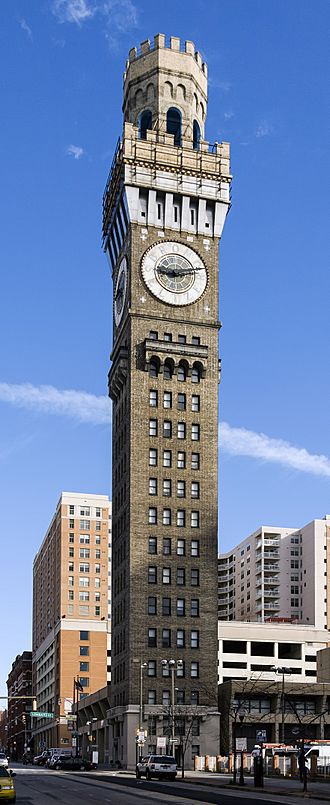Emerson Bromo-Seltzer Tower facts for kids
Quick facts for kids Bromo Seltzer Arts Tower |
|
|---|---|
 |
|
| Former names | Bromo-Seltzer Tower (Emerson Drug Company) Baltimore Arts Tower |
| General information | |
| Type | Commercial offices |
| Architectural style | Renaissance Revival |
| Location | 21 South Eutaw Street at West Lombard Street, (northeast corner), Baltimore, Maryland |
| Coordinates | 39°17′15″N 76°37′15″W / 39.2875°N 76.620833°W |
| Construction started | 1907 |
| Completed | 1911 |
| Owner | City of Baltimore |
| Management | Baltimore Office of Promotion & The Arts (formerly division in Office of the Mayor) |
| Height | |
| Roof | 88 m (289 ft) |
| Technical details | |
| Floor count | 15 |
| Design and construction | |
| Architect | Joseph Evans Sperry (1854-1930) |
|
Emerson Bromo-Seltzer Tower
|
|
| Lua error in Module:Location_map at line 420: attempt to index field 'wikibase' (a nil value). | |
| Area | 0.1 acres (0.040 ha) |
| Built | 1911 |
| Architect | Joseph Evans Sperry (1854-1930) |
| Architectural style | Romanesque |
| NRHP reference No. | 73002184 |
| Added to NRHP | June 4, 1973 |
Emerson Tower often referenced as Emerson Bromo-Seltzer Tower or the Bromo Tower is a 15-story, landmark 88 m (289 ft) clock tower erected in 1907–1911 at 21 South Eutaw Street, at the northeast corner of Eutaw and West Lombard Streets in downtown Baltimore, Maryland. It was the tallest building in the city from 1911 to 1923, until supplanted by the Citizens National Bank building (later First National Bank of Maryland, then occupied by MECU - Municipal Employees Credit Union) at the southeast corner of Light and Redwood (German) Streets. It was designed by local architect Joseph Evans Sperry (1854-1930) for Bromo-Seltzer (headache pain remedy) inventor Isaac Edward Emerson (1859-1931).
For years it was surrounded by and part of the Emerson Drug Company with its office headquarters and manufacturing plant for the carbonated headache pain relief tablets or powder Bromo-Seltzer. Later the Emerson building around it was razed and replaced by the current John Steadman Fire Station of the Baltimore City Fire Department for serving the west side of downtown Baltimore. The Steadman Station combined several earlier engine and truck companies in different firehouses on the downtown west side. Built in the Brutalist architecture style of poured concrete, the station has lines echoing the surviving tower to its south and west.
Contents
History
It was the tallest building in Baltimore from 1911 until 1923. The design of the tower along with the original factory building at its base was inspired by the Palazzo Vecchio in Florence, Italy, which was seen by Emerson during a tour of Europe in 1900. Systems engineering for the building's original design was completed by Henry Adams. The factory was demolished in 1969 and replaced with a firehouse.
The building features four clock faces adorning the tower's 15th floor on the North, South, East and West sides. Installed by the Seth Thomas Clock Company at an original cost of US$3,965, they are made of translucent white glass and feature the letters B-R-O-M-O S-E-L-T-Z-E-R, with the Roman numerals being less prominent. The dials, which are illuminated at night with LED lights are 24 feet (7.3 meters) in diameter, and the minute and hour hands approximately 12 and 10 feet (3.7 and 3.0 meters) in length respectively. Upon its completion, the Bromo Seltzer Tower featured the largest four dial gravity driven clock in the world. Originally designed to be weight driven, it was electrified in 1975 and restored to the original weight drive in 2017. The word BROMO reads clockwise, and SELTZER counterclockwise, which results in the letters being located in the following positions:
- B-10
- R-11
- O-12
- M-1
- O-2
- S-9
- E-8
- L-7
- T-6
- Z-5
- E-4
- R-3
The tower originally had a 51 ft (16 m) Bromo-Seltzer bottle, glowing blue and rotating. Weighing 20 tons (18.1 tonnes), it was lined with 314 illuminated w/ lights and topped with a crown on a clear night it could be seen from 20 miles away. The bottle was removed in 1936 because of structural concerns.
The tower was virtually abandoned in 2002, but in early 2007 the Baltimore Office of Promotion and the Arts and philanthropists Eddie and Sylvia Brown worked to transform the structure into artist studios. The Bromo Seltzer Arts Tower is now home to a variety of creative artists, writers, videographers, photographers, poets, and more. Throughout the day, artists welcome guests into their studios to view and purchase original art. The Baltimore Fire Department's John F. Steadman Fire Station, which opened in 1973 and is situated at the tower's base, houses BCFD Hazmat 1, Airflex 1, Medic1, Medic 23, MAC23, Engine 23, Rescue 1, and formerly Truck 2.
The Bromo Seltzer History Museum opened in 2015 featuring a collection of Bromo Seltzer bottles and Emerson Drug Company marketing ephemera. The Maryland Glass Room was added in 2017 to showcase the collection of cobalt blue glass bottles made by The Maryland Glass Corporation owned by Isaac Emerson.
The Emerson Bromo-Seltzer Tower was placed on the National Register of Historic Places in 1973. It is included within the Baltimore National Heritage Area.
Visiting
Clock Room Tours are on Saturdays at 11:30, 12:30, 1:30, and 2:30 for an $8 fee.
Private tours may be set up with reservations.
Free art openings occur approximately every 2 months.
Sounds of the Tower occurs every 2nd and 4th Saturdays starting at 1:00 pm.
Images for kids
See also
 In Spanish: Emerson Bromo-Seltzer Tower para niños
In Spanish: Emerson Bromo-Seltzer Tower para niños


